Abstract
Dissolved gas analysis (DGA) is a vital method for the online detection of transformer operation state. The adsorption performance of a SnP3 monolayer modified by transition metal Cr regarding six characteristic gases (CO, C2H4, C2H2, CH4, H2, C2H6) dissolved in oil was studied. The study reveals the relevant adsorption and gas-sensing response mechanisms through calculations of the adsorption energy, density of states, differential charge density, energy gap, and recovery time. The results display a considerable increase in the adsorption effect of the Cr-SnP3 monolayer on six gases. The CO, C2H2, and C2H4 gases lead to chemical adsorption, and the CH4, H2, and C2H6 gases lead to physical adsorption. Combined with the recovery time, the Cr-SnP3 monolayer has a strong adsorption effect on CO and C2H2 gases at normal temperatures and even high temperatures, and the adsorption is stable. C2H4 gas can be rapidly desorbed from the Cr-SnP3 monolayer at 398 K. Therefore, the Cr-SnP3 monolayer can be expected to serve as a CO and C2H2 gas adsorbent and a resistive gas sensor for C2H4 gas. This research offers a theoretical foundation for the development of the Cr-SnP3 monolayer in gas-sensitive materials.
1. Introduction
The transformer is the primary component of machinery in a power system; it performs the crucial functions of power transfer, distribution, and the conversion of voltage [1]. The transformer’s regular operation is crucial to the electrical system’s security, reliable operation, and power supply. Over 90% of all transformers are oil-immersed power transformers [2]. Transformer oil is a high-alkane mixture. Under long-term operation, due to pollution, high temperatures, design defects, ageing, and other reasons, hydrocarbons in transformer oil often crack and decompose into CO, C2H2, C2H4, CH4, C2H4, H2, C2H6, and other gases. These gases are often dissolved in transformer oil, so they are called dissolved fault characteristic gases in transformer oil [3]. Transformer fault types are significantly correlated with the components of the dissolved gas in oil. Therefore, by means of the sensitive identification of dissolved gas components in transformer oil, the internal fault situation and development trends in the transformer can be effectively understood, and then the insulation operation state of the transformer can be scientifically evaluated, which can effectively reduce the incidence of insulation accidents [4].
Two-dimensional (2D) materials have emerged as a popular area of study in the scientific community [5]. The distinctive structural and electrical characteristics of phosphorene and black phosphorene have garnered significant interest [6]. Among them, the phosphides of IV-V compounds, such as SnP3 [7] and GeP3 [8], have demonstrated exceptional promise in terms of their optical and electrical qualities [9]. Research in this field provides new possibilities for exploring the potential applications of new materials. The SnP3 monolayer, a two-dimensional substance, is a layered compound with a triangular space group [10], and has a honeycomb planar structure. Gas molecules are easily adsorbed onto SnP3 due to its large specific surface area. SnP3 exhibits semiconductor properties in a single-layer structure. The band gap values obtained with the PBE and HSE06 functions are 0.53 eV and 0.82 eV, respectively [11]. In addition, the SnP3 monolayer has high carrier mobility [12], and is reportedly a promising material for small gas sensing [13]. Although the intrinsic SnP3 monolayer has a limited adsorption capacity, its electronic properties can be improved using doping metals [14]. This helps to improve the sensitivity and sensor response of the SnP3 monolayer [13]. Recently, Cr has attracted increasing attention as a cheap and promising metal catalyst [15]. For example, some scholars have found that 3D transition metal Cr-doped graphene can efficiently adsorb C2H2, and the adsorption energy can reach 1.44 eV [16]. Some experts have synthesised Cr-doped SnO2 nanowires via vapour deposition and found that doping with 1.8% Cr (atomic fraction) can increase the oxygen gas-sensing performance of SnO2 nanowires by 28% at 250 °C [17]. The doping adsorption of SnP3 monolayers is less studied, particularly the gas-sensing properties after doping with noble metals [6].
Therefore, this paper proposes a modification to the doping of single-layer SnP3 with transition metal Cr. Firstly, the most stable doping structure (Cr-SnP3) was established. After this, various gas adsorption structures were built. Through geometric optimisation, the most stable Cr-SnP3 monolayer structure for the absorption of the six gases was determined. Finally, the adsorption properties of Cr-SnP3 for six gases (CO, C2H2, C2H4, CH4, H2, and C2H6) were investigated by analysing the adsorption energy, charge transfer, density of states, differential charge density, energy gap, and recovery time. This finding suggests the prospect of employing Cr-SnP3 as an absorption material for gases in the transformer oil in gas sensors.
2. Calculation Method and Structural Model
2.1. Parameter Setting
The adsorption behaviour of six gases (CO, C2H2, C2H4, CH4, H2, and C2H6) on a Cr-SnP3 monolayer was simulated. The establishment of all models and the calculations were completed using the DMol3 module of Materials Studio. The optimisation, energy, and related properties of the structure were computed using the PBE. The DNP was selected as the basis set function of the linear combination of atomic orbitals, and the Grimme method in DFT-D dispersion correction was used to correct the influence of the van der Waals force [18]. The gas molecules and transition metals used the all-electron model and DSPP treatments, respectively [19]. The convergence accuracy of SCF was 1.0 × 10−6, and the DIIS value was set to 6. The Smearing value was 0.005 Ha [20]. The whole system may have magnetic properties because Cr is a transition metal. Therefore, the electron spin was included in the calculation to ensure accuracy.
In this paper, we established a 3 × 3 × 1 single-layer SnP3 supercell periodic structure which contained 54 P and 18 Sn atoms. The vacuum layer was 20Å. The optimized lattice parameters of the SnP3 monolayer were a = b = 7.42Å, c = 10.28Å, which are almost consistent with the experimental values (a = b = 7.38Å, c = 10.51Å) [6]. The accuracy of the model was proved.
The intrinsic SnP3 monolayer was established, and different sites were doped in the folded honeycomb repeat layer. The structure of the intrinsic SnP3 and four cases are shown in Figure 1; the cases are TSn (above the Sn atom), TP (above the P atom), H1 (above the centre of the hexagonal ring composed of P and Sn), and H2 (above the centre of the hexagonal ring composed of P). Finally, the energy of each system after doping was calculated.

Figure 1.
Intrinsic SnP3 monolayer and four different doping sites.
The binding energies Eb of different dopant sites can be compared to determine the optimal doped structure, which is described by Equation (1)
where is the energy of the system after the Cr doping of SnP3; and are the energies of intrinsic SnP3 and Cr atoms, respectively.
The adsorption energy Eads was applied to assess the stability of the adsorption system, which is defined by Equation (2)
where is the energy of gas/Cr-SnP3; is the energy of the gas molecules.
The charge transfer Qt between the gas molecules and Cr-SnP3 material is calculated by Equation (3)
where Qa and Qb denote the net charge of the gas molecules after and before adsorption [21].
2.2. Dissolved Characteristic Gas in Oil
The optimized structure models of dissolved characteristic gases (CO, C2H4, C2H2, CH4, H2, and C2H6) in oil are shown in Figure 2.
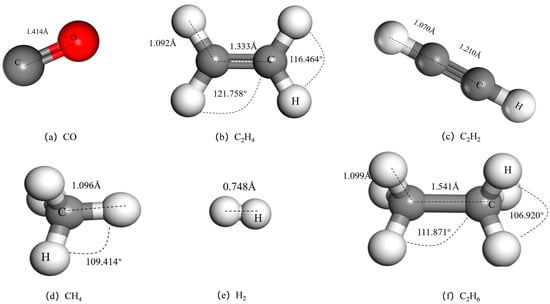
Figure 2.
Structures of (a) CO, (b) C2H4, (c) C2H2, (d) CH4, (e) H2, and (f) C2H6 molecules.
2.3. Optimised Structural Model of Cr-SnP3
The four structural parameters of Cr-doped SnP3 are shown in Table 1. Through a comparison of the absolute values of binding energy, TSn was determined to be the best doping site.

Table 1.
Structural parameters and η of four doping systems.
Chemical hardness (η) is an indicator of chemical stability. A higher chemical hardness indicates that the stability of the system is improved [22]. The η is calculated using Equation (4).
The chemical hardness of the four doping sites is shown in Table 1. Tsn corresponds to the maximum chemical hardness, indicating that the system is the most stable. This is consistent with the Eb analysis. The optimal structural model of Cr-SnP3 is shown in Figure 3.

Figure 3.
(a) Top view and (b) side view of the optimal doping structure of Cr-SnP3.
2.4. The Density of States of the Cr-SnP3 Monolayer
In order to illustrate the difference in the electronic structure of the SnP3 crystal plane before and after Cr doping, the density of states (DOS) curves were analysed, as depicted in Figure 4.

Figure 4.
(a) TDOS of intrinsic SnP3 and Cr-SnP3 monolayer; (b) PDOS of Cr-SnP3 monolayer.
The dotted line at 0 eV in Figure 4a represents the Fermi level. The total density of states (TDOS) of Cr-SnP3 follows a lower-energy path to the left, the shape changes slightly, and the valence band is filled with more electrons. However, the peak value of the TDOS before and after doping is similar, and the overall density of states is still composed of three parts—the conduction band and upper and lower valence bands—which is similar to the density of states of the intrinsic SnP3. This demonstrates that the crystal energy of SnP3 is altered by the addition of Cr atoms, but the crystal structure does not change.
The local density of states of Cr-SnP3 in Figure 4b shows that S-3P, Cr-3d, and Sn-5p have obvious overlapping peaks at −15~5 eV, which suggests that the orbitals are strongly hybridising. As a result, it may be deduced that the Cr atom and SnP3 can form a stable doping structure.
3. Analysis of Adsorption Results
3.1. Investigation of the Adsorption Properties of Cr-SnP3 on CO, C2H4, C2H2, CH4, H2, and C2H6
Since the gas molecules are placed on the Cr-SnP3 monolayer in different ways, the article established a variety of gas-monolayer adsorption systems and optimized the different positions so as to obtain the lowest energy-adsorption system. It was finally determined that the most stable adsorption configurations are achieved when gas molecules are adsorbed above the Cr atom. The optimal adsorption models of intrinsic SnP3 and Cr-SnP3 for six gases are shown in Figure 5 and Figure 6, respectively. The adsorption parameters are listed in Table 2.
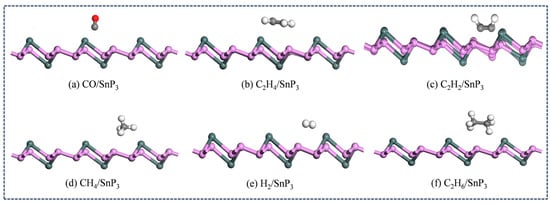
Figure 5.
The optimal adsorption model of (a) CO, (b) C2H4, (c) C2H2, (d) CH4, (e) H2, and (f) C2H6 molecules on an intrinsic SnP3 monolayer.
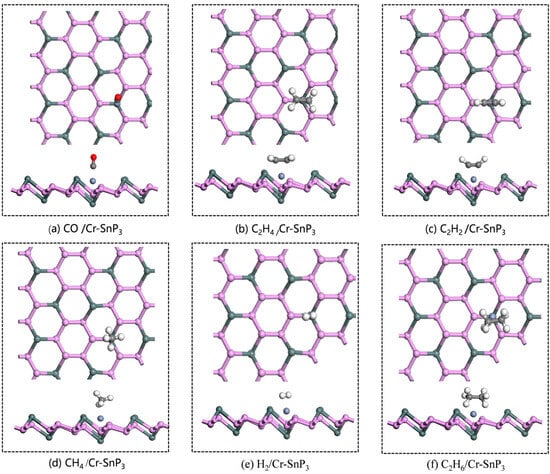
Figure 6.
The optimal adsorption model of (a) CO, (b) C2H4, (c) C2H2, (d) CH4, (e) H2, and (f) C2H6 molecules on the Cr-SnP3 monolayer.

Table 2.
Adsorption parameters of CO, C2H4, C2H2, CH4, H2, and C2H6 on SnP3 and Cr-SnP3.
In Table 2, the adsorption energy of the six gases is negative, which shows that the adsorption behaviour is a spontaneous exothermic reaction. The Eads of intrinsic SnP3 to CO, C2H4, CH4, H2, and C2H6 is relatively small, the charge transfer amount is very weak, and the adsorption distance is far. It is impossible for the five gases to be stably adsorbed on the surface of intrinsic SnP3. After the modification of SnP3 by Cr metal, the adsorption parameters increased significantly, and the overall adsorption effect was ideal. The adsorption energies of CO, C2H4, and C2H2 on Cr-SnP3 were −1.643, −1.156, and −2.129 eV, respectively, and the corresponding adsorption distances were 1.939, 2.070, and 1.896 Å, respectively. The H-C-C bond angle in C2H2 changed from 180° to 142.09°, and the C2H4’s H-C-C bond was slightly inclined upward during the surface reaction. It was preliminarily judged that the adsorption of CO, C2H4, and C2H2 molecules by the Cr-SnP3 monolayer belonged to chemical adsorption. Generally speaking, the absolute value of the adsorption energy above 0.8 eV was for chemical adsorption. The adsorption energy of CH4, H2, and C2H6 gases did not reach −0.8 eV, and the adsorption distance was far, with no significant change observed in the bond lengths. Therefore, the three gases’ adsorptions were likely to be physical adsorption.
3.2. Density of State
In this paper, the total density of states (TDOS) and partial density of states (PDOS) of six gas-adsorption systems were studied, as shown in Figure 7.

Figure 7.
TDOS and PDOS of (a1,a2) CO, (b1,b2) C2H4, (c1,c2) C2H2, (d1,d2) CH4, (e1,e2) H2, and (f1,f2) C2H6 adsorption systems.
Figure 7(a1,b1,c1) shows that the TDOS curves slightly shifted to the right after the adsorption of CO, C2H4, and C2H2 gases by Cr-SnP3. The PDOS of the three gases shows that this was due to the introduction of gas molecules and that the main contribution was from the C-2P orbitals. The C-2S, C-2P, Cr-3d, and Cr-4S orbitals formed a wide range of orbital overlaps at multiple energy levels in the −15 eV~5 eV interval with multiple overlapping peaks, indicating the existence of interatomic orbital hybridization. This confirms that the interaction between the two is chemical adsorption.
Figure 7d,e shows the curves of the CH4 and H2 adsorption systems, respectively. The TDOS curves of Cr-SnP3 before and after the adsorption of gas almost completely overlap, and the peak value does not change significantly. By observing Figure 7(d2,e2) PDOS, it can be seen that there is only a very small, almost no, overlap of orbital regions. The orbital hybridization effect is very weak, which further indicates that CH4 and H2 are only physically adsorbed on the surface of Cr-SnP3.
In Figure 7(f1,f2), the TDOS curves of C2H6/Cr-SnP3 are generally shifted to the right due to the weak orbital hybridization between C and Cr atoms, which leads to a small overlap of PDOS peaks in the range of −15 to −5 eV, but this weak orbital interaction is not sufficient to cause significant charge transfer or significant state changes.
3.3. Differential Charge Density Analysis
The differential charge density of the CO, C2H4, C2H2, CH4, H2, and C2H6 gas molecule adsorption models (red represents electron aggregation; blue represents electron depletion) are shown in Figure 8. The colour map ranges from −0.05 to 0.05 e/Å. This suggests that during the adsorption process, electrons are moved from the gas molecules to the Cr-SnP3 monolayer. In Figure 8a–c, the red electron concentration region of Cr atoms is almost directly connected to the blue electron depletion region of the gas molecules, which demonstrates that the electron exchange between gas molecules and the Cr-SnP3 monolayer is very close, and the Qt of the three gases is considerable. Therefore, the interaction between CO, C2H2, C2H4, and Cr-SnP3 monolayers is chemical adsorption. The charge transfer of CH4, H2, and C2H6 in Figure 8d–f is relatively small, so it can be assumed that the interactions between them are dominated by van der Waals forces. Differential charge density analysis verified the adsorption of the Cr-SnP3 monolayer on six gas molecules (CO, C2H4, C2H2, CH4, H2, and C2H6) from the side.
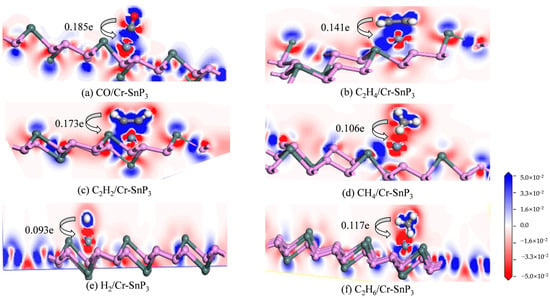
Figure 8.
Differential charge density distributions of (a) CO, (b) C2H4, (c) C2H2, (d) CH4, (e) H2, and (f) C2H6 molecules on the Cr-SnP3 monolayer.
3.4. HOMO-LUMO Energy Gaps
The HOMO, LUMO, and Eg of the intrinsic Cr-SnP3 and the gas/Cr-SnP3 system are shown in Figure 9. The energy gap (Eg) can be used to analyse the conductivity of the system [23]. For the resistive gas sensor, the change in conductivity (σ) is an important standard to evaluate the applicability of the sensor when detecting gas [24].

Figure 9.
HOMO and LUMO distributions of Cr-SnP3 monolayer and six gas-molecule-adsorption systems.
It can be seen from Figure 9 that the energy gap of the C2H2 adsorption system almost did not change much, but the energy gap in the CO, C2H4, CH4, H2, and C2H6 adsorption systems decreased significantly, and the reduction ranges were 54.8%, 53.7%, 30%, 43.7%, and 10%, respectively. The Eg of the system decreases after adsorption, suggesting that the system’s conductivity is growing. As the Cr-SnP3 monolayer has a poor adsorption effect on CH4, H2, and C2H6, the Cr-SnP3 monolayer may be employed as a gas-sensitive sensor material for detecting CO and C2H4.
3.5. Recovery Time
Recovery time is an important metric that has to be considered in practical gas sensor requirements, as a too-small or too-large recovery time is not ideal for gas sensors [25]. A longer recovery time will make the sensor more difficult to remove [26]. The recovery time τ and the adsorption energy Eads can be related, and can be calculated by Equation (5).
where A is the attempt frequency (1012 s−1); EB is equal in magnitude to the adsorption energy [25]; KB is the Boltzmann constant (8.62 × 10−5 eVK−1); T is the Kelvin temperature.
In this paper, the recovery time of 298 K, 348 K, 398 K, and 448 K at four different temperatures was calculated. The recovery time of six gases is shown in Table 3. It can be seen that CH4, H2, and C2H6 have a short recovery time due to their low adsorption energy. The recovery rate is extremely fast in the temperature range of 298 K~448 K, which takes less than 1s. It is verified from the side that the adsorption of CH4, H2, and C2H6 on the surface of Cr-SnP3 is extremely unstable. The Cr-SnP3 monolayer is not appropriate for detecting these three gases, and it is also impossible to achieve the effective removal of these three gases.

Table 3.
Recovery time of six gases at different temperatures.
Since CH4, H2, and C2H6 molecules have been repeatedly confirmed to have no good adsorption characteristics on the Cr-SnP3 monolayer, only the recovery times of CO, C2H4, and C2H2 are presented. A recovery time histogram of the three gases is shown in Figure 10. Combined with the chart analysis, it was determined that the recovery time of CO and C2H2 gases was very long in the temperature range of 298 K~448 K. In the normal temperature environment, the recovery time was as long as several decades, which demonstrates that CO and C2H2 may be adsorbed by the Cr-SnP3 monolayer with excellent effectiveness. Nevertheless, for C2H4 gas, the recovery time decreases to 496 s at 398 K and 11.12 s at 448 K, which indicates that the recovery time of the C2H4 gas is ideal, so Cr-SnP3 can be quickly recycled. The conductivity changes greatly, which meets the requirements of actual gas sensors. However, the temperature should not be too high; otherwise, the recovery time is too short to detect C2H4. Following a comprehensive analysis, the Cr-SnP3 monolayer can be considered as an adsorbent for CO and C2H2 gases, and it can be used as a resistive gas sensor for C2H4 at about 398 K.
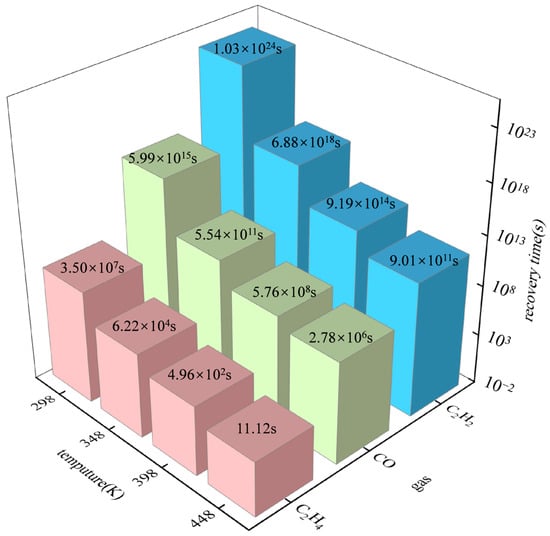
Figure 10.
Recovery time of C2H2, CO, and C2H4.
3.6. Comparison of Intrinsic and Doped SnP3 Monolayers for the Adsorption of Dissolved Gases in Six Oils
To further explore the possibility of using SnP3 monolayers as a gas-sensitive sensor material for application in the power industry, the absolute values of the adsorption energy of SnP3, Pd-SnP3 [20], and Cr-SnP3 monolayers on the six gases are compared. The comparison results are shown in Figure 11. Intrinsic SnP3 has large adsorption energy only for C2H2 and adsorption energy is poor for other gases. The addition of Pd or Cr resulted in a significant increase in the adsorption of six gases, especially CO, C2H4, and C2H2. It can be observed from the figure that Cr-SnP3 is better adsorbed compared to Pd-SnP3. Not only does the Cr-SnP3 exhibit a stable adsorption capacity for CO and C2H2, it has both an adsorption effect and an excellent recovery time for C2H4.
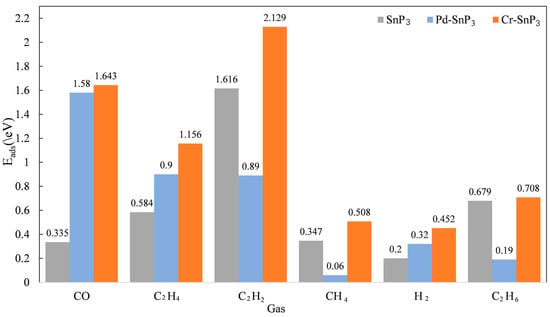
Figure 11.
Comparison of the adsorption energy of SnP3, Pd-SnP3, and Cr-SnP3 monolayers on dissolved gas in oil.
Cr and Pd are both transition metals, but Cr is more widely used and has a higher output, making it more readily available. The metal Cr has a significant cost advantage. Therefore, the addition of Cr is an effective means for SnP3 to adsorb and detect gases.
4. Conclusions
This work offers a comprehensive investigation of the adsorption process of six gases (CO, C2H4, C2H2, CH4, H2, and C2H6) on the Cr-SnP3 monolayer. The conclusions are as follows:
- (1)
- Compared with the intrinsic SnP3 monolayer, the adsorption effect of a Cr-SnP3 monolayer on six dissolved gases (CO, C2H4, C2H2, CH4, H2, and C2H6) in oil was significantly enhanced. The growth rates of the adsorption energy were 390.4%, 97.9%, 31.7%, 46.3%, 126.1%, and 4.2%, respectively.
- (2)
- The adsorption energies of CO, C2H4, C2H2, CH4, H2, and C2H6 on the Cr-SnP3 monolayer are −1.643, −1.156, −2.129, −0.508, −0.452, and −0.708 eV, respectively. The adsorption strengths were C2H2 > CO > C2H4 > C2H6 > CH4 > H2. The gas molecules of C2H2, CO, and C2H4 undergo chemical adsorption, and the gas molecules of C2H6, CH4, and H2 undergo physical adsorption.
- (3)
- Considering the energy gap and recovery time, the Cr-SnP3 monolayer can be considered a high-performance adsorbent for CO and C2H2 gases and a resistive gas sensor for C2H4.
In conclusion, SnP3 is a promising gas-sensitive and adsorbent material. We hope that this paper will strongly promote the gas-sensing application of the Cr-SnP3 and contribute to state-monitoring technology for oil-immersed power equipment in the future. This paper mainly focused on a theoretical study of the ideal case. We will be committed to improving this theoretical research with experimental data in the future.
Author Contributions
Conceptualization, C.W. and X.L.; methodology, X.L.; software, X.L.; validation, X.L. and F.X.; formal analysis, X.L.; investigation, X.L. and X.W.; resources, X.L.; data curation, X.L.; writing—original draft preparation, X.L.; writing—review and editing, X.L.; visualisation, P.Z.; supervision, F.X.; project administration, X.W.; funding acquisition, C.W. All authors have read and agreed to the published version of the manuscript.
Funding
This research received no external funding.
Institutional Review Board Statement
Not applicable.
Informed Consent Statement
Not applicable.
Data Availability Statement
The original contributions presented in the study are included in the article, further inquiries can be directed to the corresponding author.
Conflicts of Interest
The authors declare no conflicts of interest.
References
- Lee, H.-J.; Yoon, S.W.; Yoon, Y.-D. Hybrid distribution transformer based on an existing distribution transformer and a series-connected power converter. J. IEEE Trans. Power Deliv. 2022, 37, 4202–4211. [Google Scholar] [CrossRef]
- Ali, M.S.; Omar, A.; Jaafar, A.S.A.; Mohamed, S.H. Conventional methods of dissolved gas analysis using oil-immersed power transformer for fault diagnosis: A review. J. Electr. Power Syst. Res. 2023, 216, 109064. [Google Scholar] [CrossRef]
- Cui, H.; Zhang, X.; Zhang, G.; Tang, J. Pd-doped MoS2 monolayer: A promising candidate for DGA in transformer oil based on DFT method. Appl. Surf. Sci. 2019, 470, 1035–1042. [Google Scholar] [CrossRef]
- Yingang, G.; Wenjun, L.; Xin, H.; Zhuyu, D.; Chao, T.; Lingna, X. Adsorption properties of pristine and Co-doped TiO2 (1 0 1) toward dissolved gas analysis in transformer oil. Appl. Surf. Sci. 2020, 507, 145163. [Google Scholar]
- Chakroborty, S. MXenes: From Research to Emerging Applications; CRC Press: Boca Raton, FL, USA, 2024. [Google Scholar]
- Yupeng, L.; Qu, Z.; Hongwan, M.; Jingxuan, W.; Wen, Z. Gas-sensing mechanism of Cr doped SnP3 monolayer to SF6 partial discharge decomposition components. Appl. Surf. Sci. 2021, 546, 149084. [Google Scholar]
- Zhang, N.; Li, X.; Ruan, S.; Chen, X.; Li, S.; Hu, T. First-Principles Study of Electronic Properties of Substitutionally Doped Monolayer SnP3. J. Mater. 2022, 15, 2462. [Google Scholar] [CrossRef]
- Wu, Y.; Yuan, J.; Li, X.; Zhang, X. GeP3 monolayer as a promising 2D sensing materials in detecting SO2, H2S, SOF2 and SO2F2. J. Phys. Scr. 2024, 99, 085956. [Google Scholar] [CrossRef]
- Sara, A.A.; Cai, X.; Li, X.; Wang, H. 2D-SnP3 as Promising Candidate for NO Sensor with High Sensitivity and Selectivity at Room Temperature: A First-Principles Investigation. Phys. Status Solidi B-Basic Res. 2023, 260, 2300235. [Google Scholar] [CrossRef]
- Wang, C.; Hu, T.; Kan, E. Two-dimensional VDW crystal SnP3 with high carrier mobility and extraordinary sunlight absorbance. Chin. J. Chem. Phys. 2019, 32, 327–332. [Google Scholar] [CrossRef]
- Zhu, X.-L.; Liu, P.-F.; Zhang, J.; Zhang, P.; Zhou, W.-X. Monolayer SnP3: An excellent p-type thermoelectric material. Nanoscale 2019, 11, 19923–19932. [Google Scholar] [CrossRef]
- Song, H.; Zhang, X.; Yuan, P.; Hu, W.; Gao, Z. First-principles study on bilayer SnP3 as a promising thermoelectric material. PCCP 2022, 24, 29693–29699. [Google Scholar] [CrossRef] [PubMed]
- Wang, H.; Hu, X.; Liu, B.; Duan, D. Pd-doped SnP3 monolayer: A new 2D buddy for sensing typical dissolved gases in transformer oil. Appl. Surf. Sci. 2021, 568, 150893. [Google Scholar] [CrossRef]
- Yingang, G.; Xiao, P.; Kai, L.; Zhuyu, D. Adsorption of C2H2, CH4 and CO on Mn-doped graphene: Atomic, electronic, and gas-sensing properties. Physica E 2020, 119, 113959. [Google Scholar]
- Chandra, M.; Yadav, S.; Rawat, R.; Singh, K. Enhancement of magnetoelectric coupling in Cr doped Mn2O3. J. Phys. Condens. Matter 2020, 32, 295703. [Google Scholar] [CrossRef] [PubMed]
- Liao, Y.; Peng, R.; Peng, S.; Zeng, W.; Zhou, Q. The Adsorption of H2 and C2H2 on Ge-Doped and Cr-Doped Graphene Structures: A DFT Study. Nanomaterials 2021, 11, 231. [Google Scholar] [CrossRef] [PubMed]
- Zhang, L.; He, J.; Jiao, W. Synthesis and gas sensing performance of NiO decorated SnO2 vertical-standing nanotubes composite thin films. Sens. Actuator B-Chem. 2019, 281, 326–334. [Google Scholar] [CrossRef]
- Zeng, F.; Qiu, H.; Feng, X.; Chao, X. Ti3C2Tx as a sensor for SF6/N2 nitrogen-containing fault decomposition characteristic products: A theoretical study. Nanomaterials 2022, 12, 2311. [Google Scholar] [CrossRef]
- Wang, M.; Chen, D.; Jia, P. Adsorption and sensing performances of air decomposition components (CO, NOx) on Cr modified graphene surface. Inorg. Chem. Commun. 2023, 157, 111447. [Google Scholar] [CrossRef]
- Liu, Y.; Hou, W.; Zhou, Q.; Chen, W. Investigation on Adsorption and Sensing Performance of Characteristic Gas in Oil on Palladium-doped SnP3 Monolayer Based on Density Functional Theory. Proc. CSEE 2023, 43, 2040–2050. [Google Scholar]
- Wang, M.; Chen, D.; Jia, P. Gas sensitive analysis of composite MoS2(001) surface to air discharge products: A DFT study. IEEE Sens. J. 2023, 23, 22188–22195. [Google Scholar] [CrossRef]
- Chatterjee, S.; Bandyopadhyay, D. Hydrogen storage on MgO supported TiMgn (n = 2–6) clusters: A first principle investigation. J. Int. J. Hydrogen Energy 2024, 77, 1467–1475. [Google Scholar] [CrossRef]
- Braga, L.S.; Leal, D.H.; Kuca, K.; Ramalho, T. Perspectives on the role of the frontier effective-for-reaction molecular orbital (FERMO) in the study of chemical reactivity: An updated review. Curr. Org. Chem. 2020, 24, 314–331. [Google Scholar] [CrossRef]
- Gui, Y.; Chen, Y.; Zhang, X.; Chen, W.; Chen, X. Adsorption Properties of Pd Doped GaNNTs Nanotubes to Transformer Oil Dissolved C2H4 Gas. High Volt. Eng. 2022, 48, 1462–1470. [Google Scholar]
- He, X.; Gui, Y.; Xie, J.; Liu, X.; Wang, Q.; Tang, C. A DFT study of dissolved gas (C2H2, H2, CH4) detection in oil on CuO-modified BNNT. Appl. Surf. Sci. 2020, 500, 144030. [Google Scholar] [CrossRef]
- Wang, C.; Xiang, S.; Wu, J.; Wang, L.; Wang, H.; Wan, S. First-principles study on the adsorption properties of CuO-doped C3N to the decomposition components of C5F10O. J. At. Mol. Phys. 2024, 41, 49–56. [Google Scholar]
Disclaimer/Publisher’s Note: The statements, opinions and data contained in all publications are solely those of the individual author(s) and contributor(s) and not of MDPI and/or the editor(s). MDPI and/or the editor(s) disclaim responsibility for any injury to people or property resulting from any ideas, methods, instructions or products referred to in the content. |
© 2024 by the authors. Licensee MDPI, Basel, Switzerland. This article is an open access article distributed under the terms and conditions of the Creative Commons Attribution (CC BY) license (https://creativecommons.org/licenses/by/4.0/).